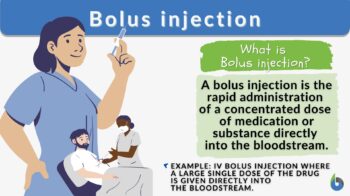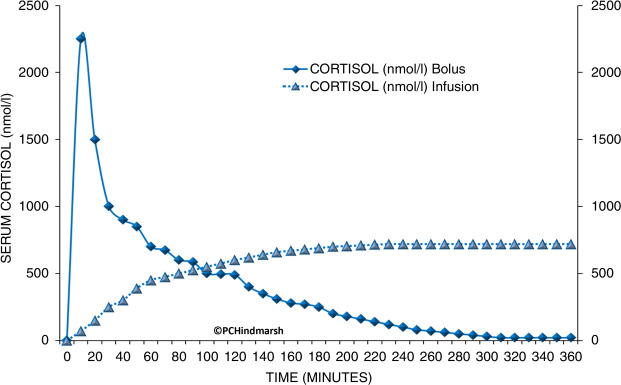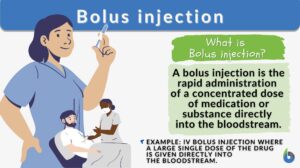
Bolus injection
n., plural: bolus injections
[ˈbəʊləs ɪn.ˈd͡ʒɛk.ʃən/]
Definition: The rapid administration of a concentrated dose of medication or substance directly into the bloodstream
Table of Contents
A bolus injection is the act of administering a dose of medication or substance directly into the bloodstream by injection. This technique bypasses the digestive system. Thus, the drug or substance is absorbed rapidly, and therefore, the effects manifest quickly. This practice is commonly seen in medical settings. It is applied for the rapid achievement of the desired effects. It is administered when a fast response is required, especially in emergency situations. Its use is also considered when precise control over drug delivery is necessary.
Read on to find answers to common questions on bolus injection, like “What is a bolus injection?”, “What does bolus dose mean?”… Learn about the proper bolus injection techniques, placement, and medication in diabetes, veterinary medicine, and radiation therapy.
Bolus Injection Definition
A bolus injection is the administration of a concentrated dose of medication or substance rapidly and directly into a patient’s bloodstream or a specific site in the body using a syringe. The dose or drug concentration is determined based on the weight, medical condition, and medical history of the patient.
The purpose of a bolus is to achieve a quick and immediate effect, often bypassing the digestive system to ensure rapid absorption and onset of action.
Bolus injections are commonly used in medical settings for emergency treatments, pain management, anesthesia induction, diabetes management (insulin bolus), and various other therapeutic purposes. For instance, a patient with a high fever due to infection or microbial disease would need a high volume of antibiotics in the bloodstream in order to start working quickly.
The antimicrobial action of the antibiotic is necessary so that the disease and high fever of the patient would be managed or controlled in no time. This method of drug administration is usually followed by the administration of a longer-term, slower-acting intravenous drip line of medication.
Watch this vid about bolus injection:
Biology definition:
A bolus injection is the administration of the drug(s) in a bolus, i.e. a large volume, at once. A bolus, in this sense, is a single, large dose of a drug. Bolus injections become necessary when a patient needs a particular medication to immediately circulate in the bloodstream.
What does bolus mean?
The word bolus comes from the Latin noun bolus meaning “a lump” or “a mass”. It has its roots in the Greek word “bolos”, which also means “a lump” or “a clod”. The term was later adopted into various European languages with similar meanings. The term “bolus” has become widely used in biology where it refers to the mass of chewed food mixed with saliva that will be swallowed down the esophagus for further digestion. However, the context of bolus in digestion is different from the bolus in medicine and pharmacology which define bolus as a concentrated dose of medication or substance administered to the patient. So while bolus refers to the semi-solid mixture of food and saliva, bolus in a medical definition goes far by using it to refer to the pharmacological drug that is administered as one large dose.
With that information, the succeeding topics below will focus on the medical context of bolus, i.e., the bolus fluids, which are the drugs or substances given in a concentrated dose.
Injection as bolus administration
Injection is the process of introducing a substance into the body using a needle and syringe or other medical devices. Thus, bolus injection refers to the direct administration of a single, large dose of bolus fluids into the body (e.g., into the bloodstream) by means of a needle and syringe. This is especially useful in critical situations where there is a need for immediate hydration or when rapid delivery of medications is necessary.
Take note though that bolus may also be administered apart from the standard syringe injection. Another bolus administration is done via a feeding tube. A bolus is fed directly into the stomach or intestine through a tube. The choice of administration depends on the patient’s medical condition and the speed at which the desired effect is hoped to achieve.
Placement
The most common method of administering a bolus is through intravenous or IV injection. Other routes for bolus fluid delivery include intramuscular, subcutaneous, epidural, and intrathecal injections.
Table 1: Bolus Injection Routes | ||||
|---|---|---|---|---|
| Intravenous (IV) Bolus Injection | Intramuscular (IM) Bolus Injection | Subcutaneous (SC) Bolus Injection | Epidural Bolus Injection | Intrathecal Bolus Injection |
| Intravenous bolus injection is the direct injection into a vein | Intramuscular bolus injection into a muscle | Subcutaneous bolus injection is just beneath the skin, into the subcutaneous tissue | An injection into the epidural space, usually around the spinal cord | Injection into the intrathecal space, within the spinal canal |
| For rapid drug administration to achieve immediate effects or to deliver a concentrated dose of medication directly into the bloodstream | For delivering medication when rapid absorption and immediate action are required, but IV access is not available or not preferred | For delivering medications that require slow and sustained absorption, leading to a prolonged effect | To provide targeted pain relief or anesthesia for specific procedures or during labor and delivery | To deliver medication directly to the cerebrospinal fluid, providing pain relief or anesthesia |
| Intravenous injection examples: IV bolus of antiarrhythmic drugs to rapidly treat and convert certain cardiac arrhythmias IV bolus of bronchodilators, like salbutamol (albuterol) or terbutaline for severe asthma or acute bronchoconstriction IV bolus doses of anticonvulsant medications, such as lorazepam or diazepam to manage and stop acute seizures | Intramuscular injection examples: IM bolus of antibiotic, such as ceftriaxone, to treat a bacterial infection IM bolus of epinephrine (Adrenaline) for severe allergic reactions (anaphylaxis) or cardiac arrest IM bolus of lorazepam for rapid sedation and to control seizures | Subcutaneous injection examples: SC bolus of insulin to manage blood sugar levels in a person with diabetes after a meal SC hyaluronic acid injections to fill wrinkles or add volume to the skin | Epidural injection examples: Epidural bolus injections of local anesthetics, such as bupivacaine or lidocaine, are commonly used to provide pain relief during labor and delivery Epidural bolus injections of corticosteroids, such as methylprednisolone, are used to reduce inflammation and alleviate pain associated with conditions like herniated discs or spinal stenosis | Intrathecal injection example: Intrathecal bolus injections of opioids, such as morphine or fentanyl, for potent pain relief for acute and chronic pain conditions, especially in cases where oral or systemic medications are ineffective or not tolerated |
Bolus Injection vs. Infusion
Infusion refers to the administration of a drug or substance in a continuous line using an infusion pump. Similar to an IV bolus injection, an infusion is administered directly into the vein. However, an infusion is given continuously whereas an IV bolus injection is provided in a single shot.
In the chart below depicting the infusion and bolus dose example of hydrocortisone, have you noticed how a bolus injection of hydrocortisone resulted in a high level of cortisol in the bloodstream?
The concentrated single dose of hydrocortisone resulted in a peak, however, it only lasted for a few hours. After about five to six hours, there is little cortisol left. But with infusion, there is a steady state of cortisol. However, the cortisone level at the start tends to increase not abruptly but gradually then it reaches a steady state. With infusion, the high cortisol level in the bloodstream takes about a few hours before achieving the desired amount.

Because of this, the standard practice is to administer a bolus injection to cover for the first few hours and then this is followed by an infusion. (Hindmarsh & Geertsma, 2017)
Now, let’s take a look at the different real-life scenarios where a medical bolus is administered. The clinical implications of bolus injection in medical practice are essential for immediate and precise therapeutic interventions.
Diabetes
There are two types of diabetes: Type 1 (diabetic patient not producing enough insulin) and Type 2 (diabetic patient that produces enough insulin but is not responding to it). Insulin is a hormone produced by the pancreas that helps regulate glucose (sugar) in the bloodstream.
One way to manage diabetes, especially Type 1, using bolus medication is by injecting insulin to manage blood sugar levels. Two major types of insulin are used: basal insulin (which provides a slow and steady release of insulin throughout the day) and bolus insulin (a rapid-acting insulin that is administered in response to the amount of carbohydrates consumed).
Bolus injection appears to mimic how natural insulin works, i.e., working in response to meals. When a diabetic person eats, blood sugar rises. Thus, the best time to administer is typically before or after the meal. Nevertheless, the injection duration of insulin bolus (the time it takes to administer rapid-acting insulin directly into the patient’s bloodstream) will depend on the specific type of rapid-acting insulin being used.
The timing and dosage of the bolus injection are typically calculated by the medical practitioner based on vital factors such as the carbohydrate content of the meal, current blood sugar levels, and insulin sensitivity.
Veterinary Medicine
Similar to human bolus injections, this form of bolus administration is done similarly — rapid delivery in a concentrated dose directly into the bloodstream of the animals, such as dogs, cats, horses, cattle, and other livestock.
This is particularly useful…
- As emergency treatments for critical conditions, such as poisoning, anaphylactic reactions, dehydration, nutritional/vitamin deficiencies, and so on
- For quick pain relief
- For anesthesia delivery, especially prior to surgical procedures
Radiation Therapy
In radiation therapy, a certain type of bolus material has advanced features wherein it can modify the radiation dose distribution and protect sensitive structures during treatment. Such a type of bolus in radiation therapy is referred to as the “preserving bolus”. This bolus, unlike the other bolus injections, is applied to the skin surface or the superficial tissues.
It helps to increase the dose that can be delivered to treat superficial tumors or lesions while attenuating the dose to the underlying healthy tissues, thus, minimizing the side effects.
Some common bolus materials include specialized gels, wax sheets, or other materials. The choice of bolus material will depend on factors such as the depth of the treatment target and the specific radiation beam energy used.
NOTE IT!
Bolus Injection Technique
The bolus injection technique via IV route involves the rapid administration of a concentrated dose of a drug directly into the patient’s bloodstream. Hence, it is crucial to do it correctly and properly. Below is a step-by-step guide commonly practiced when performing a bolus injection. This, however, has to be done by a medical professional.
- Preparing the medication. This is done by gathering the medication or substance prescribed by the healthcare provider. Make sure to have the correct dosage and concentration for the patient. Double-check the mediation label, dosage, and expiration date. Also, make sure that the hands have been washed and cleaned before handling the medication or syringe.
- Preparing the syringe. A sterile syringe with the appropriate volume of the medication is used.
- Drawing the prescribed amount of medication. This is done by inserting the needle into the vial or ampule. There should be no air bubbles (one way to remove them is by pushing the plunger to expel the air).
- Cleaning the IV bolus injection site with an alcohol swab.
- Administering the injection. The dominant hand is often used to hold the syringe while the other hand is for stabilizing the skin near the injection site. The needle is inserted at a slight angle carefully and gently to avoid or minimize the discomfort of the patient. When administering an IV bolus, the syringe plunger is pulled back slightly to check for blood return. When blood enters the syringe, a new site is chosen; without blood, the medication can be administered to the site with care. The speed of injection may vary depending on the specific guidelines of the medication as well as the patient’s tolerance.
- Withdrawing the needle after delivering the entire bolus. Gentle pressure to the injection site with a sterile gauze pad is usually applied to prevent bleeding and minimize bruising.
- Discarding the used syringe and needle properly by following proper disposal guidelines
- Documenting the injection, e.g., the patient’s medical chart, including the medication, dosage, site, date, and any other relevant details.
Take the Bolus Injection – Biology Quiz!
References
- Hindmarsh, P. C., & Geertsma, K. (2017). Intravenous, Intramuscular and Other Forms of Hydrocortisone. https://doi.org/10.1016/b978-0-12-811483-4.00027-1.
- Enderle, J. D. (2012). Compartmental Modeling. 359–445. https://doi.org/10.1016/b978-0-12-374979-6.00007-1
- Calculating Bolus Injections. (2023). Nationwidechildrens.org. https://www.nationwidechildrens.org/family-resources-education/health-wellness-and-safety-resources/resources-for-parents-and-kids/managing-your-diabetes/chapter-seven-calculating-bolus-injections
©BiologyOnline.com. Content provided and moderated by Biology Online Editors.








